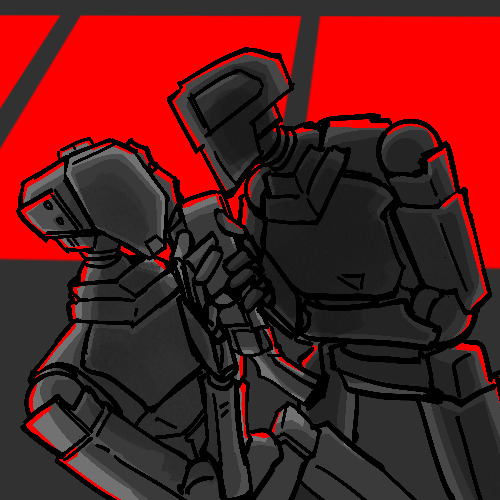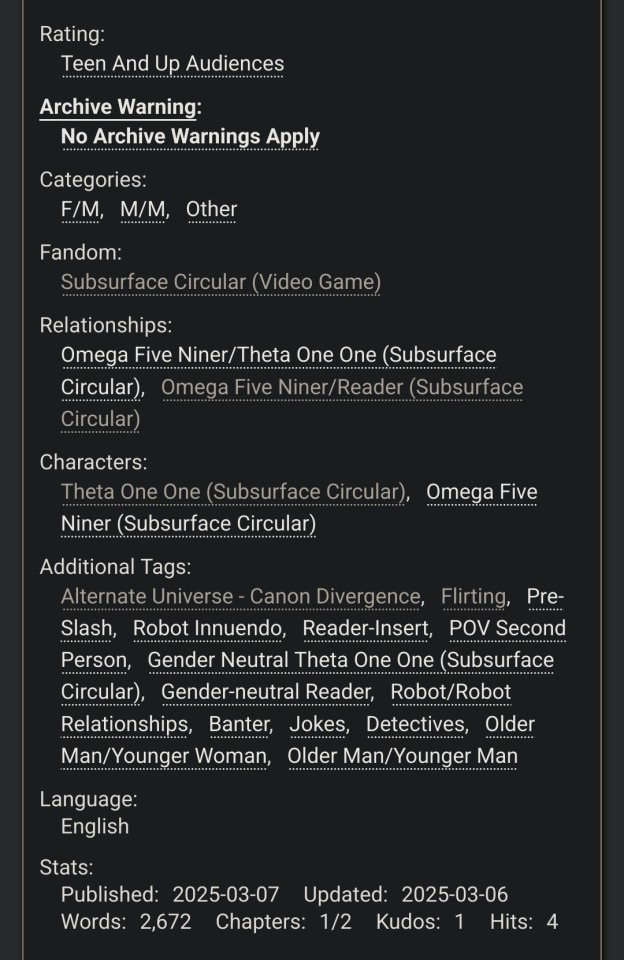#Subsurface Circular
Explore tagged Tumblr posts
Text

#my art#subsurface circular#ough. good game. fucked up game. insane#did not expect it to hit me that hard its REALLY good#also short and sweet 💯thank you shepard for recommending it on your steam sale recs
100 notes
·
View notes
Text


I'm writing Subsurface Circular fanfiction btw. if u even care.
#my fic#subsurface circular#theta one one#omega five niner#where are my robot dilf enjoyers#robot x robot#robot x reader
0 notes
Text

















Subsurface Circular をプレイしてクリアしました。
3.5h ぐらい。ネイティブならもっと早いと思います。
文章量はまあまあ、ボキャブラリーはたまに難しい。UIが洗練されているのでなんとなくでも進めれます。
James One One として地下鉄に乗りながら他のTek達から失踪事件に対しての調査をしていくお話。
最後はスケールが大きくなってTekの人間に対するクーデターを止めるかまで託される。(特大ネタバレ)
ロボットや地下鉄の車内のデザインはsci-fi特有のおしゃれさがあるし、舞台設定も結構凝っている。それぞれのTek達は色々な職業についておりそれゆえの悩みや固有能力があったりして面白いです。
UIもとても良い。触っていて心地よかったです。変な選択肢選んでもゲームオーバーになりません。
リニアなゲームでストーリーを楽しむゲーム。ちょっとしたsci-fiチックなお話を楽しみたいって方にお勧めです。
英語に抵抗ない方ならサクッと遊べるのでお勧めです。
0 notes
Text
Ok I guess this week has been all about going through a bunch of short stuff (and finishing one old thing I was almost done with), so you get to drink from the firehose.
The old thing was Bayonetta 2, which for some reason I took a break from for like 2-3 years. The first game had a bunch of good ideas in it but felt like it wasn't quite finished to me, but this one improved on all that and polished everything better, and it was a lot of fun. I'm not great at it, especially not after trying to jump back in in the middle after not playing for multiple years, but I was managing ok by the end at least. It's just non-stop nonsense that's constantly escalating and getting more ridiculous, and somehow they manage to pull that off. I kind of almost wish they leaned even more into the camp aspects of it sometimes, because the moments where Bayonetta comes across as "what if a cis woman was a gay man?" are always fun, and I'm always a sucker for female characters who are kind of snarky/bitchy/sarcastic.
Subsurface Circular was pretty good too. I knew the name Mike Bithell in the opening credits sounded familiar but was not prepared for it to directly reference Thomas Was Alone (the original thing he became known for and another great game) at one point in the story. "You are a robot detective solving robot crimes by talking to other robots on the subway" is a great premise, and it went in some reasonably interesting directions I wasn't expecting by the end. Some of the characters are kind of fun too.
I gave up on Can Androids Survive really quickly, like a few minutes in, which is a shame after how amazing Can Androids Pray was. I actually have a feeling it's probably fine or even good, but I didn't love the default controls, and when I tried to remap them the game softlocked. I'll probably give it another shot at some point when it goes on sale on itch.io or Steam, but the Switch version isn't happening.
Florence was pretty cute and good though. It's another one of those things that manages to tell a story and develop its characters with almost zero text or dialogue, and it does it well. I don't really have a ton to say about it beyond that it's a good use of a couple bucks and less than an hour of your time. Oh, and that I appreciate the stuff they managed to pull off entirely through very simple gameplay, like showing characters getting closer and more comfortable with each other just through how you put together speech bubbles for implied conversations. Very simple but very effective.
And then finally there's Death Becomes You, which I have mixed feelings on. I guess I'd call it a yuri murder mystery VN with much more emphasis on the murder mystery than the yuri. There are definitely some good ideas in it, and I like that it's not afraid to focus on toxic or even abusive relationships and recovering from them, and the world it takes place in is more interesting than I expected. That said, the writing isn't really my style overall. Some of it works pretty well sometimes, but I had a bit of a rough time getting into it at first because of how unlikable the characters and their interactions came across at first, and not in a way that made me want to know more. I did warm up to them somewhat, but like a review on Steam put it I was more intellectually interested in what the story was doing and not so much emotionally invested in the characters or what was going on. Also most of the endings feel really abrupt and like they needed slightly more to them to feel like they were really earned. I'm still curious what they'll do in the future though because there's definitely potential for something interesting there.
#bayonetta 2#bayonetta series#subsurface circular#can androids survive#florence#death becomes you#mentioned:#thomas was alone
0 notes
Text
also i finally started playing Subsurface Circular today, and I love it. I enjoy a good talking simulator detective game!!! gotta pay attention and accumulate the knowledge!!! it's good. though i am starting to wish i had a steamdeck so I could play it on the couch rather than at my desk. Body Hurty
1 note
·
View note
Text
Played through Mike Bithell's Tron Identity earlier this month. Started playing Tron 2.0 from Monolith for the first time this past weekend. Both have blown me away.
Cleaning up those corners of Tron I haven't touched yet. I think there was a comic published at one point I need to hunt down. The world of Tron really is peak
#ftt#tron#I should pickup Subsurface Circular too#I grew up on Thomas Was Alone and had respect for Bithell but that game seemed to have slipped past my radar#Any suggestions for Tron related media I'm all open. I've been through Legacy/Uprising but this is the first time I'm delving deeper
96 notes
·
View notes
Text

Possible tectonic activity on Venus
Using archival data from the mission, launched in 1989, researchers have uncovered new evidence that tectonic activity may be deforming the planet’s surface
ast, quasi-circular features on Venus’ surface may reveal that the planet has ongoing tectonics, according to new research based on data gathered more than 30 years ago by NASA’s Magellan mission. On Earth, the planet’s surface is continually renewed by the constant shifting and recycling of massive sections of crust, called tectonic plates, that float atop a viscous interior. Venus doesn’t have tectonic plates, but its surface is still being deformed by molten material from below.
Seeking to better understand the underlying processes driving these deformations, the researchers studied a type of feature called a corona. Ranging in size from dozens to hundreds of miles across, a corona is most often thought to be the location where a plume of hot, buoyant material from the planet’s mantle rises, pushing against the lithosphere above. (The lithosphere includes the planet’s crust and the uppermost part of its mantle.) These structures are usually oval, with a concentric fracture system surrounding them. Hundreds of coronae are known to exist on Venus.
Published in the journal Science Advances, the new study details newly discovered signs of activity at or beneath the surface shaping many of Venus’ coronae, features that may also provide a unique window into Earth’s past. The researchers found the evidence of this tectonic activity within data from NASA’s Magellan mission, which orbited Venus in the 1990s and gathered the most detailed gravity and topography data on the planet currently available.
“Coronae are not found on Earth today; however, they may have existed when our planet was young and before plate tectonics had been established,” said the study’s lead author, Gael Cascioli, assistant research scientist at the University of Maryland, Baltimore County, and NASA’s Goddard Space Flight Center in Greenbelt, Maryland. “By combining gravity and topography data, this research has provided a new and important insight into the possible subsurface processes currently shaping the surface of Venus.”
As members of NASA’s forthcoming VERITAS (Venus Emissivity, Radio science, InSAR, Topography, and Spectroscopy) mission, Cascioli and his team are particularly interested in the high-resolution gravity data the spacecraft will provide. Study coauthor Erwan Mazarico, also at Goddard, will co-lead the VERITAS gravity experiment when the mission launches no earlier than 2031.
Mystery Coronae
Managed by NASA’s Jet Propulsion Laboratory in Southern California, Magellan used its radar system to see through Venus’ thick atmosphere and map the topography of its mountains and plains. Of the geological features the spacecraft mapped, coronae were perhaps the most enigmatic: It wasn’t clear how they formed. In the years since, scientists have found many coronae in locations where the planet’s lithosphere is thin and heat flow is high.
“Coronae are abundant on Venus. They are very large features, and people have proposed different theories over the years as to how they formed,” said coauthor Anna Gülcher, Earth and planetary scientist at the University of Bern in Switzerland. “The most exciting thing for our study is that we can now say there are most likely various and ongoing active processes driving their formation. We believe these same processes may have occurred early in Earth’s history.”
The researchers developed sophisticated 3D geodynamic models that demonstrate various formation scenarios for plume-induced coronae and compared them with the combined gravity and topography data from Magellan. The gravity data proved crucial in helping the researchers detect less dense, hot, and buoyant plumes under the surface — information that couldn’t be discerned from topography data alone. Of the 75 coronae studied, 52 appear to have buoyant mantle material beneath them that is likely driving tectonic processes.
One key process is subduction: On Earth, it happens when the edge of one tectonic plate is driven beneath the adjacent plate. Friction between the plates can generate earthquakes, and as the old rocky material dives into the hot mantle, the rock melts and is recycled back to the surface via volcanic vents.
On Venus, a different kind of subduction is thought to occur around the perimeter of some coronae. In this scenario, as a buoyant plume of hot rock in the mantle pushes upward into the lithosphere, surface material rises and spreads outward, colliding with surrounding surface material and pushing that material downward into the mantle.
Another tectonic process known as lithospheric dripping could also be present, where dense accumulations of comparatively cool material sink from the lithosphere into the hot mantle. The researchers also identify several places where a third process may be taking place: A plume of molten rock beneath a thicker part of the lithosphere potentially drives volcanism above it.
Deciphering Venus
This work marks the most recent instance of scientists returning to Magellan data to find that Venus exhibits geologic processes that are more Earth-like than originally thought. Recently, researchers were able to spot erupting volcanoes, including vast lava flows that vented from Maat Mons, Sif Mons, and Eistla Regio in radar images from the orbiter.
While those images provided direct evidence of volcanic action, the authors of the new study will need sharper resolution to draw a complete picture about the tectonic processes driving corona formation. “The VERITAS gravity maps of Venus will boost the resolution by at least a factor of two to four, depending on location — a level of detail that could revolutionize our understanding of Venus’ geology and implications for early Earth,” said study coauthor Suzanne Smrekar, a planetary scientist at JPL and principal investigator for VERITAS.
Managed by JPL, VERITAS will use a synthetic aperture radar to create 3D global maps and a near-infrared spectrometer to figure out what the surface of Venus is made of. Using its radio tracking system, VERITAS will also measure the planet’s gravitational field to determine the structure of Venus’ interior. All of these instruments will help pinpoint areas of activity on the surface.
8 notes
·
View notes
Text
We do this not because it is easy...
...but because we thought it would be easy.
It's been a while, and I need to put out a blog post or I'm going to go insane. This post was meant to be "Species Highlight - Sepia", which is still sitting in my drafts half finished. Instead, this is going to be a post about burnout and some not-quite-finished things I've been cycling between for Prima Materia. If there's one thing you take away from this post, let it be that you need to take care of yourself and take breaks. You need to rest or your body and mind will force you to rest and it won't be fun.
Last time I made a blog post, I promised that you would get the Sepia, and barring that I was sure that I would be able to get my "next experiment" up and running by the time the week was out. It turns out, I was very wrong. The experiment in question was an attempt to try and write mechanics relevant to the kind of adventures I wanted to see in Prima Materia. This entails actually writing a module, then seeing what mechanics it would require and writing those mechanics. I figured I'd churn out three modules that were intended to run for 3 sessions each, and start playtesting. To probably no one's surprise who's ever done the insane amount of work it takes to write a module that can be run by another human being, this hasn't worked.
The first module is currently unfinished, and I am still excited about it and want to finish it; however I ran into burnout while writing it over the course of a few weeks because I agonized about it not getting done and agonized when I was writing it because I was tired of writing the same thing. I then ran into several life snags that haven't allowed me to work on it. I won't go into details of my personal life here but suffice to say stress has been high and time has been relatively short. Add burnout into this and you have a recipe for not even thinking about Prima Materia for a month and some change.
So, in order to get back into the groove of trying to write, I decided to be a little self serving and write a part of the setting that I wanted to write right then because I finally got hit with the inspiration beam again. This bit of writing will have no relevance to anything for probably years down the line in this project, but it's fun and interesting to me so it served as a wonderful tool for diving back in. I will share with you the little blurb that I wrote about a planet that exists in the setting, though it is hardly even a first draft so much as a note. Names are placeholders and everything here is subject to change.
Ternaki Log(?) World: Carcosa; cold eyeball planet orbiting a red dwarf Carcosa is a planet engineered by the "Architects," a group of aliens that were active between three and four billion years ago. They left a beacon in orbit of the planet that tells us this planet is called "Carcosa" and was the work of an individual named "Hastur." Dating methods used on the beacon and ice core samples taken from the cold side of the planet reveal that this was likely one of Hastur's later works. The planet's crust is comprised of mostly water ice and water, which experiences varying degrees of tectonic activity. A circular portion on the day side is hot enough for this water ice to melt, resulting in the usually hidden subsurface ocean to be visible. In this melted portion there are a few rocky continents and a number of hot spots resulting in island chains and active volcanism. The continental portions are home to several forms of native life, mostly plant-like in nature. Native life on Carcosa has signature markers placed by Architect gene weavers, and share genetic similarities with several nearby planetary biospheres which are unrelated to each other. The native plants can be divided into two categories that use either red or blue pigment in photosynthesis. Animals on Carcosa are wildly varied, but due to the high gravity of the planet most are either very small or very robust. There is one native sapient species on the planet that boasts several civilizations; many of which use bronze tools. In modern times, Carcosa has been designated as a resort planet / nature preserve with several island chains being co-opted for resort use, and is listed as one of the 7 ancient wonders of the galaxy in several major periodicals. The planet is managed by a satellite station in orbit of the planet, which has been in place for several centuries.
The joke here is I saw the meme about the flat earth ice wall planet actually existing (specifically this planet spied by JWST) and decided to make something like it in Prima Materia.
So what's the current project?
When approaching everything again, I came face to face with more design decisions I made in the past that didn't mesh well with what I want Prima Materia to be. Namely, I don't want there to be a class system in the game for several reasons, but there are two main reasons. Firstly, because I want player characters to be able to learn whatever the character would be able to conceivably learn (within the bounds of the system, this isn't a simulation game). Secondly, while I want both vertical and horizontal progression, I want the progression to be more horizontal than it is vertical. I find that classes lend themselves more to vertical power systems and particularly power fantasies (at least when I write them). The profession system I have is just a class system I've been pretending isn't a class system because I cleverly called it something else. So, I've dissected the profession system because it was still in the early stages and divided up the parts to other systems, which made way for at least one new system (quirks of the soul) as well as trees of features that are specifically related to things like combat, medicine, or specific kinds of alchemy.
That was a lot of the word "system." In short, Prima Materia in my brain currently looks like a disassembled car, but I have a checklist to put it back together better than it was before. In fact, here's the checklist:

The checklist isn't finished (and some stuff may be removed or changed) but it has enough to keep me busy for a while, and enough where if I start getting burnt out on one part of the project I can switch gears and start writing other parts. Currently, I'm working on quirks of the soul (working title) and integrating that into the character creation system.
That module I talked about earlier will definitely be finished at some point, though that will happen after more of this checklist is done. I'd love to tell you more but.. Spoilers. All-in-all I'm considering the experiment with side by side module / mechanics development to be.. a teachable moment.
If you read this far, thank you very much for your interest! I need to spruce up the "Species Highlight - Sepia" post before getting it out but I hope to put it up before or on the 16th, @donutboxers art has languished in my drafts long enough it needs to be seen.
Tl;dr: I'm not dead and neither is Prima Materia.
12 notes
·
View notes
Note
trick or treeeeaaaaat ^_^
Your evil blorbo is Theta One One (Subsurface Circular)

15 notes
·
View notes
Text
With the steam summer sale ending in a few days, here’s a list I’d compiled earlier of great games currently under £5 ($6.40)
We Know The Devil is £1. 03
Heaven Will Be Mine is £1. 70
Cultist Simulator is £3.74
Full Metal Furies is £3.35
Pyre is £3.35
Transistor is £3.35
Bastion is £2.55
Rogue Legacy is £2.55
Misericorde is £3.71
Tangle Tower is £3.35
TOEM is £3.35
The Red Strings Club is £2.55
Thomas was alone is £1.19
Death's Door is £4.18
Journey is £3.59
Subsurface Circular is £0.95
Magicka 2 is £3.19
Monster Prom is £2.32
Monster Camp is £3.39
Celeste is £1.67
Castle Crashers is £0.99
A Short Hike is £3.18
Landlord of the Woods is £0.44
Dicey Dungeons is £2.77
Little Inferno is £3.18
FIGHT KNIGHT is £2.84
Aragami is £2.24
Hope this helps you find something good!
7 notes
·
View notes
Text
Fave character tag game
Rules: Make a poll with five of your all-time favorite characters and then tag five people to do the same. See which character is everyone’s favorite!
thanks for the tag @staubhase :D





i'll tag... @kajenus, @nodaudaboutitt, @sweet-mephistopheles, @ruvviks, and @kozlatko
7 notes
·
View notes
Text

Streaming in a little under 2 hours! At 2pm CT I'm gonna try out The Beginner's Guide and maybe Subsurface Circular if we finish early.
Twitch.tv/Akamaru0101
4 notes
·
View notes
Text
TRON: Catalyst - Official Trailer
youtube
"TRON: Catalyst pulls you back into the world of Disney’s TRON to battle multiple opposing factions in the latest imaginative story from Bithell Games (Thomas Was Alone, Subsurface Circular, TRON: Identity). TRON: Catalyst is an all-new story-driven, isometric action-adventure game, set in the immersive and diverse locations of the Arq Grid introduced in TRON: Identity.
Play as Exo, a highly resilient and resourceful program wielding an unexpected power known as the Glitch, gaining strength and abilities which the overlords of the Arq Grid’s crumbling society seek to bring under control. Ride Light Cycles, engage in Identity Disc combat, and more as you’re relentlessly pursued through the city and beyond by Conn, a malevolent program with an agenda of his own, while uncovering more about the glitches that threaten the stability of this world.
TRON: Catalyst is coming to PC, PS5, Xbox Series X|S and Nintendo Switch in 2025."
3 notes
·
View notes
Text
Carbon Capture Utilization and Storage (CCUS) Market Competitive Landscape and Strategic Insights to 2033
Introduction
As the global community intensifies efforts to combat climate change, Carbon Capture, Utilization, and Storage (CCUS) has emerged as a critical technology for reducing greenhouse gas emissions. CCUS refers to the process of capturing carbon dioxide (CO2) emissions from industrial and energy-related sources, utilizing them for various applications, or storing them underground to prevent their release into the atmosphere. This technology plays a pivotal role in transitioning to a low-carbon economy and achieving net-zero emissions targets.
This article explores the trends, growth drivers, challenges, and market forecasts for the CCUS industry up to 2032.
Download a Free Sample Report:-https://tinyurl.com/3t7e9h3n
Market Overview
The CCUS market is experiencing rapid growth, driven by increasing regulatory pressures, technological advancements, and the urgent need to address climate change. Governments, corporations, and international organizations are investing heavily in CCUS infrastructure to curb CO2 emissions while maintaining economic growth.
Key Market Trends
1. Government Policies and Incentives
Governments worldwide are implementing stringent regulations to curb carbon emissions. Policies such as carbon pricing, tax credits, and subsidies are encouraging industries to adopt CCUS technologies. For instance, the U.S. Inflation Reduction Act has expanded tax incentives for carbon capture projects, making them more financially viable.
2. Rising Corporate Commitments to Net Zero
Major corporations are increasingly committing to net-zero emissions goals, leading to investments in CCUS technologies. Industries such as oil and gas, cement, and steel, which are traditionally difficult to decarbonize, are particularly focusing on CCUS as a solution.
3. Technological Advancements
Innovations in CO2 capture technologies, including direct air capture (DAC) and bioenergy with carbon capture and storage (BECCS), are improving efficiency and reducing costs. Advances in solvent-based and membrane-based capture methods are also making CCUS more feasible for widespread adoption.
4. Growth of Carbon Utilization Applications
Captured CO2 is increasingly being used in various applications, including enhanced oil recovery (EOR), the production of synthetic fuels, and as a feedstock in chemicals and materials manufacturing. This utilization not only offsets costs but also contributes to a circular carbon economy.
5. Expansion of Storage Infrastructure
There is a growing focus on expanding geological storage sites, particularly in regions with favorable subsurface conditions, such as North America, the North Sea, and Australia. Investments in carbon transportation and sequestration networks are crucial to scaling up CCUS deployment.
Market Segmentation
By Technology
Pre-combustion Capture
Post-combustion Capture
Oxy-fuel Combustion Capture
Direct Air Capture (DAC)
By End-Use Industry
Oil & Gas
Power Generation
Cement & Concrete
Chemicals & Fertilizers
Iron & Steel
By Region
North America
Europe
Asia-Pacific
Latin America
Middle East & Africa
Market Forecast (2024-2032)
The CCUS market is projected to witness significant growth between 2024 and 2032. Several reports estimate that the market, valued at approximately $3 billion in 2023, could surpass $10 billion by 2032, with a compound annual growth rate (CAGR) exceeding 15%. Key drivers of this growth include:
Increased investments from both public and private sectors.
Advancements in CCUS technology reducing operational costs.
Rising industrial adoption in hard-to-abate sectors.
Expanding carbon credit markets and financial incentives.
Challenges and Restraints
Despite its potential, CCUS faces several challenges:
1. High Costs and Economic Viability
CCUS remains capital-intensive, with high upfront costs for capture, transportation, and storage infrastructure. Economic viability is often dependent on government incentives and carbon pricing mechanisms.
2. Infrastructure and Scalability Issues
The widespread adoption of CCUS requires significant expansion of CO2 transportation networks and storage facilities, which presents logistical and regulatory hurdles.
3. Public Perception and Environmental Concerns
There is public skepticism regarding the long-term safety and effectiveness of CO2 storage, particularly related to potential leakage risks. Addressing these concerns through transparent research and regulatory oversight is crucial for broader acceptance.
4. Policy and Regulatory Uncertainty
While some regions have strong policy support for CCUS, others lack clear regulations or long-term commitments, creating uncertainty for investors and project developers.
Future Outlook
The future of CCUS appears promising as global efforts to combat climate change intensify. Key developments expected in the coming years include:
Integration with Renewable Energy: CCUS combined with green hydrogen production and bioenergy solutions could create a more sustainable energy ecosystem.
Digital and AI Innovations: The use of artificial intelligence (AI) and digital twins for optimizing CCUS operations and monitoring storage integrity.
Collaboration and Partnerships: Governments, private sector players, and research institutions will continue forming strategic alliances to accelerate deployment.
Conclusion
Carbon Capture, Utilization, and Storage (CCUS) is set to play a vital role in global decarbonization efforts. Driven by regulatory policies, technological advancements, and corporate sustainability commitments, the market is poised for significant growth through 2032. However, challenges related to costs, infrastructure, and public perception must be addressed to ensure widespread adoption. With continued investment and innovation, CCUS can become a cornerstone of a net-zero future, supporting both environmental sustainability and economic growth.
The next decade will be crucial in determining the extent to which CCUS can scale up and become a mainstream solution in the fight against climate change.Read Full Report:-https://www.uniprismmarketresearch.com/verticals/energy-power/carbon-capture-utilization-and-storage-ccus
0 notes
Text
Magnaflux MPI Machine- Best MPI Machine Manufactures In India

MPI Machine test bench units are more advanced than the standard machines used for MPI inspection. They are employed in a broad range of industries like aerospace, marine automotive, oilfield equipment & railways to detect surface & subsurface defects. These are two vector machines. A circular magnetic field is generated by clamping the part between the headstock & tailstock & passing a current through the part. Parts with a central bore may be tested by the threaded bar method. The longitudinal magnetic field is produced by changeover made through solid-state circuitry.
#PLCMagnafluxMachine#MagneticParticleInspection#MagnafluxTesting#PLCControlledSystems#MagnafluxInspection#AutomationAndControl#PLCProgrammingTutorials
0 notes
Text
Choosing the Right Irrigation System for Australian Water Challenges

Australia’s dry climate and limited water resources make efficient irrigation systems vital for agriculture. Farmers must balance water conservation with crop health to ensure sustainability. Understanding the different types of irrigation and selecting the ideal system for Australian conditions can significantly improve water efficiency and yield outcomes.
Types of Irrigation Systems
Several irrigation methods are used across Australia, each with its strengths and weaknesses. The choice depends on factors like water availability, soil type, and crop requirements.
Surface Irrigation
This traditional method involves distributing water over the soil surface, allowing it to flow into fields through gravity. While simple and inexpensive, surface irrigation is less water-efficient, as it can result in significant losses through evaporation and runoff.
Drip Irrigation
Drip systems deliver water directly to the base of plants through emitters, ensuring minimal wastage. This method is highly efficient, reducing water loss through evaporation and preventing overwatering. Drip irrigation is ideal for Australian farmers aiming to conserve water while maintaining healthy crops.
Sprinkler Irrigation
Sprinklers mimic rainfall by spraying water over crops. They are suitable for a wide range of crops and soil types, offering flexibility. However, sprinklers can be less efficient in windy or hot conditions, where water may evaporate before reaching the plants.
Centre Pivot Irrigation
Commonly used in large fields, centre pivot systems rotate around a central point, irrigating crops in a circular pattern. This method is effective for uniform watering but may require significant water availability.
Subsurface Irrigation
Subsurface irrigation systems place water delivery pipes beneath the soil. This approach reduces evaporation and targets root zones directly, making it one of the most water-efficient methods. It’s particularly suited for high-value crops and regions with water scarcity.
The Ideal Irrigation System for Australia
With water scarcity being a significant concern, Australian farmers increasingly adopt efficient methods like drip and subsurface irrigation. These systems conserve water by delivering it directly to the root zone, reducing evaporation and runoff.
In regions with limited water access, drip irrigation is often the best choice due to its precision and adaptability to various crops. Farmers who manage large-scale operations might prefer centre pivot systems for their efficiency in irrigating vast fields, provided water resources are sufficient.
For those seeking tailored solutions, exploring irrigation supplies can provide valuable insights into the tools and equipment available.
Cost and Accessibility
The cost of implementing an irrigation system can vary, depending on the type and scale of the setup. Farmers should weigh the long-term savings from improved water efficiency against the initial investment. To balance expenses, reviewing rural fencing prices can help identify affordable solutions for complementary infrastructure.
For those in Western Australia, exploring irrigation supplies online Perth offers a convenient way to source equipment suited to local conditions.
Choosing the right irrigation system is crucial for Australian farmers managing water scarcity. Efficient methods such as drip and subsurface irrigation not only conserve water but also support sustainable farming practices. By investing in modern irrigation solutions, farmers can secure reliable yields and protect Australia’s precious water resources.
0 notes